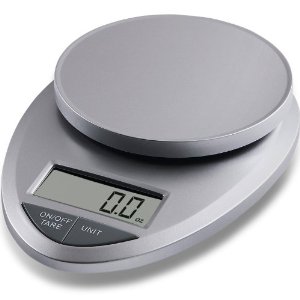When starting out on a new diet one of things that you need to quickly learn is true portion sizes. Sitting down and eating a few handfuls of chips is not one serving. It’s more like 5 servings at more points than your daily allowance. That’s pretty obvious right? What’s not obvious is the difference between 2 or 3 ounces when you are eyeballing it. That’s why you need to know what to look for in a food scale.
A good food scale is important not just for measuring out a snack’s serving size , but also for understanding the portion size of a recipe and how to modify recipes. When making over a recipe we have to understand and define how many servings are in each dish but we can’t do that without knowing what we are starting out with. That’s where our food scale comes in.
Here is what to look for in a food scale:
- Multiple Measurement Units – The serving size found on nutritional labels various from product to product. Additionally, recipes from other countries may call for measures not as cups but as grams. Don’t limit yourself to just one measurement unit! By having multiple units of measure you can remove some of the math from cooking. You want to worry about how something is going to taste, not about dividing or multiplying fractions. The food scale that we use has ounces, pounds, grams and kilograms.
- Tare Feature – Tare features allow you to eliminate the weight of a serving dish or plate. You simply place a plate, bowl, pot or pan onto the scale and then press the tare button. Your scale will reset to “0” and you place the item on the plate to get the true weight of the food. This is a helpful feature that allows you to measure both wet and dry ingredients and keeps your food scale clean.
- Maximum Weight – When comparing food scales, look for one that has a high maximum weight. This will allow you to weigh foods in a heavy pot or pan (like a Le Creuset) and not just be limited to your standard plates and bowls. The food scale that we use has a max weight of a 11lbs.
Now that you know what to look for in a food scale, finding one should be easy. Our food scale of choice is the EatSmart Precision Pro Digital Kitchen Scale which we purchased for $25. In addition to meeting all of the requirements above it only has two buttons – one for unit of measure and one for tare. That makes using our kitchen scale even easier.
Nerd Alert: One of the most things I love to measure the most is marinades. One of my favorite recipes is honey chicken but I always end up throwing half of the marinade away. I always measure the marinade before I put the chicken in the bag and after I take it out. Why? Because you don’t want all of the points or calories of the marinade to be counted when you are throwing half of it away!
Once you begin cooking with a food scale you will wonder how you ever cooked without one. If you are like us you will find yourself measuring everything with it – before and after it’s cooked. The next thing you know, you’ll be the one telling your friends what to look for in a food scale.









[…] example of why having a quality food scale is critical to have in your kitchen. Here’s a post about the one I […]